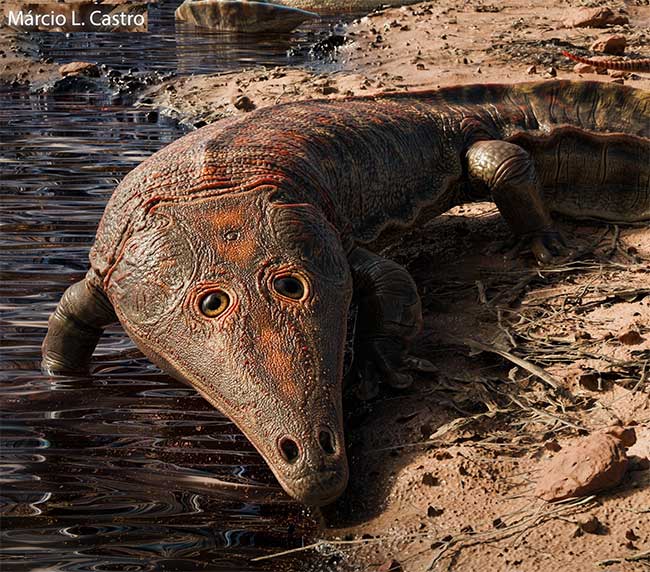This strange sea monster not only created a new species but also added the name of a new animal genus to the paleontological record .
Recreated by Brazilian scientists with a creepy and different face, the animal with a body that looks like a crocodile but with smoother skin and a strange 4-sided tail is an amphibious sea monster of the Triassic period ( 200-251 million years ago).
In that primitive world, its 1.5m size was gigantic. By comparison, the first dinosaurs – which appeared at the end of this era – were only about the size of modern lizards and geckos.
A study has been opened between the Federal University of the São Francisco Valley (Brazil), Princeton University and Harvard University (USA).
 Water monster Kwatisuchus rosai – (Photo: Márcio Castro).
Water monster Kwatisuchus rosai – (Photo: Márcio Castro).
According to Sci-News, the new species is named Kwatisuchus rosai , which is also a completely new genus of the Benthosuchidae family , a lineage of crocodile-like aquatic monsters called “temnospondyl”.
However, other species from this family were previously found only in Eastern Europe. The fact that one species in the family tree appears in remote South America suggests that this lineage is much more widespread than previously thought.
The fossil skull of Kwatisuchus rosai was found in August 2022 from the Sanga do Cabral formation in Rio Grande do Sul – Brazil, where there was a complex river, lake and swamp system in ancient times.
It is a sedimentary rock formation that records a terrible historical period of the planet: A “desolate” environment after the Nhi Diep – Tam Diep great extinction, also the largest great extinction on the planet, where Most ocean creatures have disappeared.
Kwatisuchus rosai is a survivor. At 249 million years old, this creature lived right after the mass extinction.
The reason for this exceptional survival – despite large size being a disadvantage – may be due to amphibians’ high ability to adapt to environmental stress conditions.
According to Dr. Estevan Eltink from the Federal University of São Francisco Valley, amphibians are the most diverse group of primitive tetrapods, recorded on every continent on Earth.
Thanks to their high survival ability, amphibians are a timebook that helps people understand more about how mass extinction events affect the planet, as well as what will happen when the next mass extinction strikes. .
Unfortunately, even though it overcame the greatest disaster to Earth’s creatures, Kwatisuchus rosai still could not leave descendants to this day.





